Leadership and Management Operations Report: Marks & Spencer Analysis
VerifiedAdded on 2021/01/01
|20
|6579
|85
Report
AI Summary
This report delves into the core concepts of management and operations, focusing on the roles and characteristics of leaders and managers within the context of Marks & Spencer. It contrasts the functions of leaders and managers across different situations, emphasizing the importance of adapting to change. The report further explores the application of various leadership theories, including situational leadership, system leadership, and contingency theory, to support organizational growth and sustainable performance. Key approaches to operation management are discussed, highlighting their role in achieving business objectives. The report also analyzes the impact of factors within the business environment on management operations, providing a comprehensive overview of the subject matter. It covers interpersonal and decisional roles of managers, and honesty and sense of humor as characteristics of leaders. Different leadership styles and their strengths and weaknesses are discussed to provide a detailed analysis of the leadership and management.
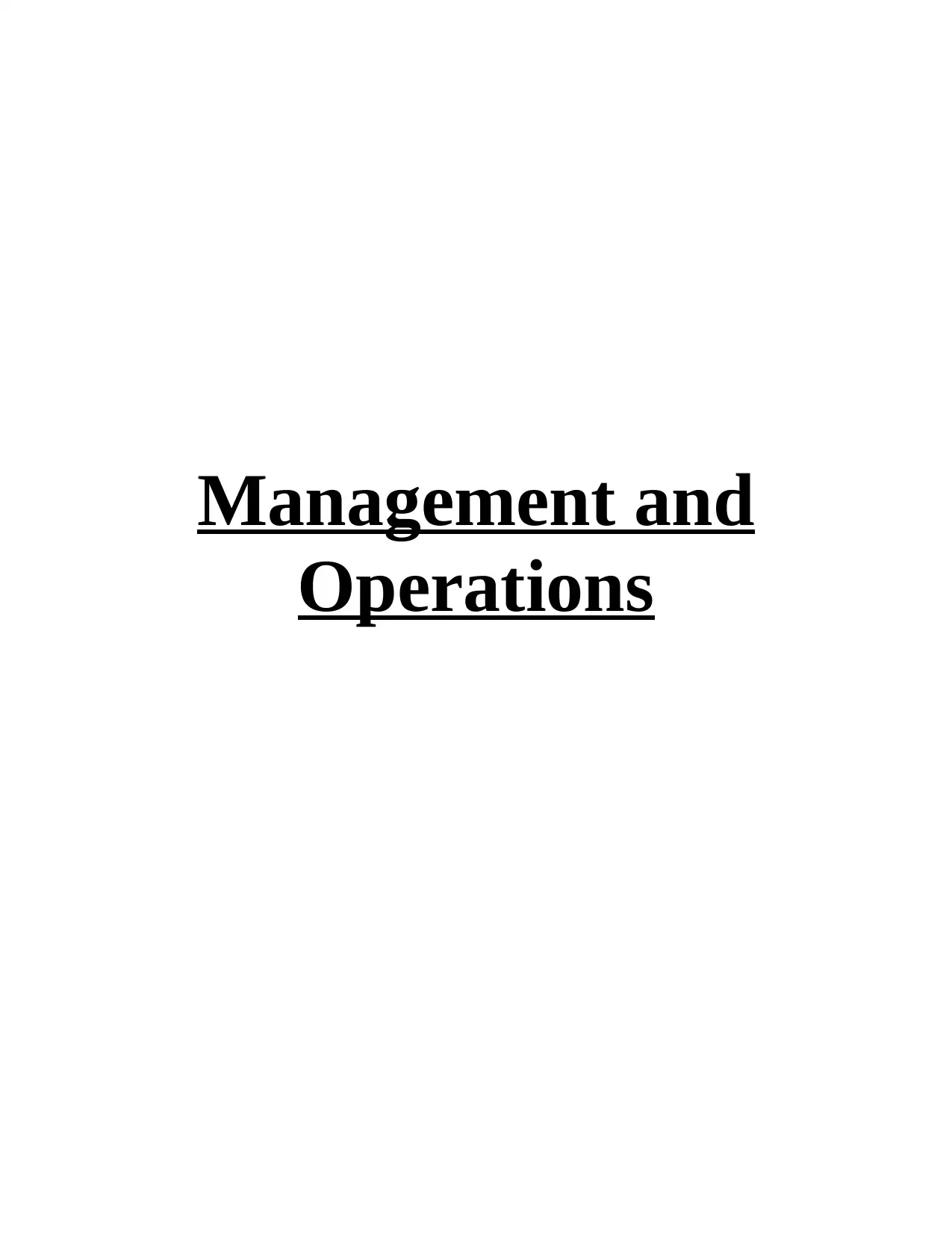
Management and
Operations
Operations
Paraphrase This Document
Need a fresh take? Get an instant paraphrase of this document with our AI Paraphraser
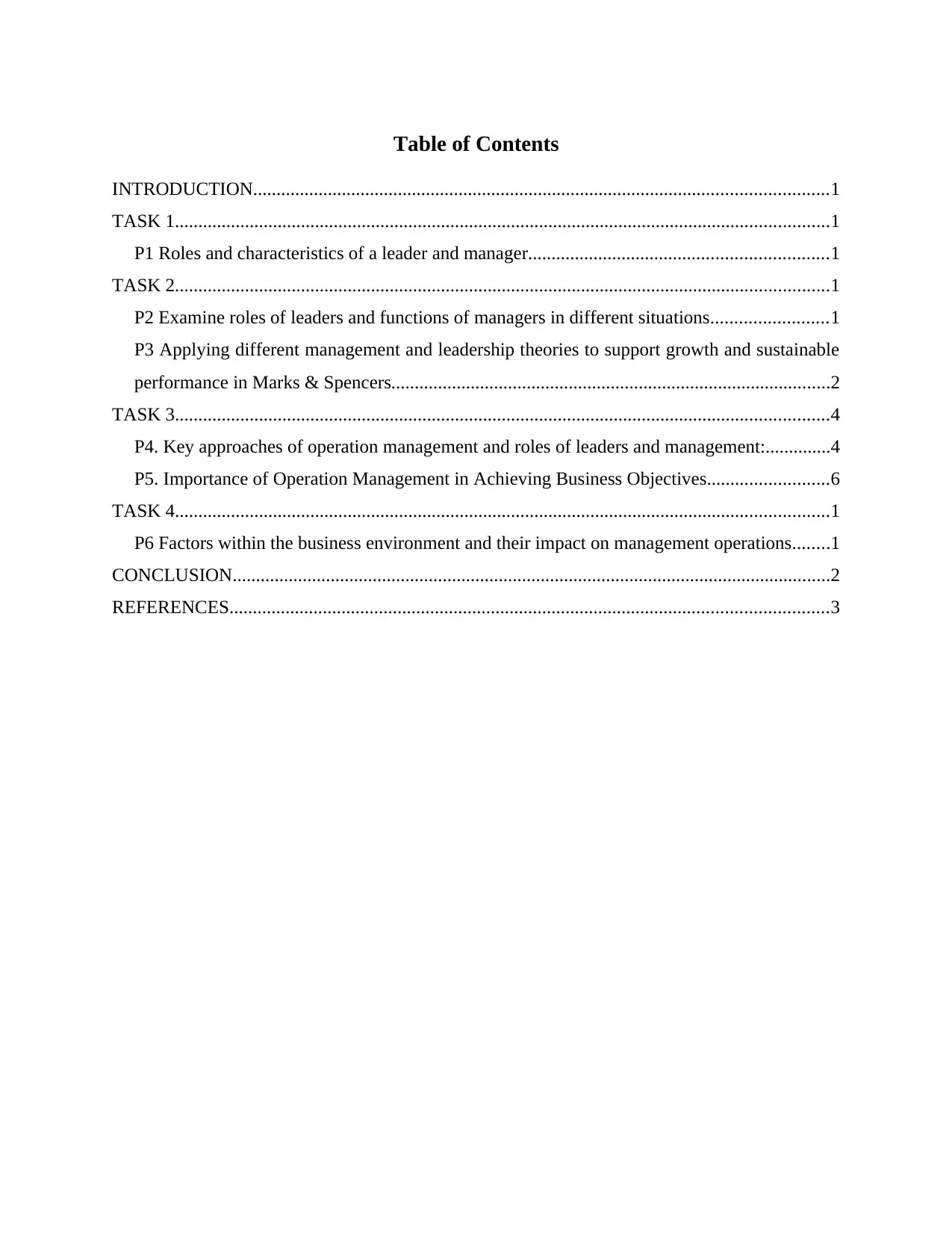
Table of Contents
INTRODUCTION...........................................................................................................................1
TASK 1............................................................................................................................................1
P1 Roles and characteristics of a leader and manager................................................................1
TASK 2............................................................................................................................................1
P2 Examine roles of leaders and functions of managers in different situations.........................1
P3 Applying different management and leadership theories to support growth and sustainable
performance in Marks & Spencers..............................................................................................2
TASK 3............................................................................................................................................4
P4. Key approaches of operation management and roles of leaders and management:..............4
P5. Importance of Operation Management in Achieving Business Objectives..........................6
TASK 4............................................................................................................................................1
P6 Factors within the business environment and their impact on management operations........1
CONCLUSION................................................................................................................................2
REFERENCES................................................................................................................................3
INTRODUCTION...........................................................................................................................1
TASK 1............................................................................................................................................1
P1 Roles and characteristics of a leader and manager................................................................1
TASK 2............................................................................................................................................1
P2 Examine roles of leaders and functions of managers in different situations.........................1
P3 Applying different management and leadership theories to support growth and sustainable
performance in Marks & Spencers..............................................................................................2
TASK 3............................................................................................................................................4
P4. Key approaches of operation management and roles of leaders and management:..............4
P5. Importance of Operation Management in Achieving Business Objectives..........................6
TASK 4............................................................................................................................................1
P6 Factors within the business environment and their impact on management operations........1
CONCLUSION................................................................................................................................2
REFERENCES................................................................................................................................3
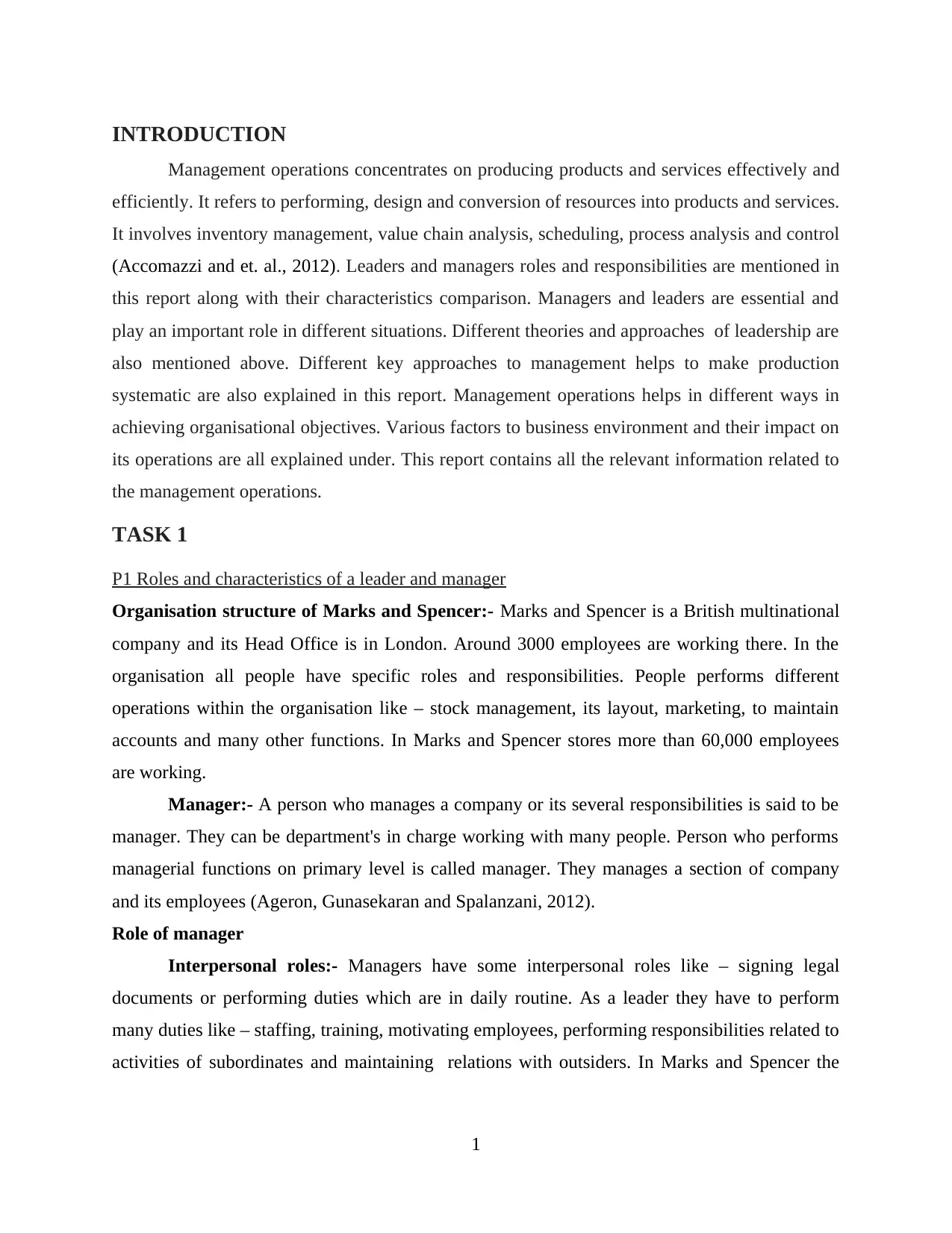
INTRODUCTION
Management operations concentrates on producing products and services effectively and
efficiently. It refers to performing, design and conversion of resources into products and services.
It involves inventory management, value chain analysis, scheduling, process analysis and control
(Accomazzi and et. al., 2012). Leaders and managers roles and responsibilities are mentioned in
this report along with their characteristics comparison. Managers and leaders are essential and
play an important role in different situations. Different theories and approaches of leadership are
also mentioned above. Different key approaches to management helps to make production
systematic are also explained in this report. Management operations helps in different ways in
achieving organisational objectives. Various factors to business environment and their impact on
its operations are all explained under. This report contains all the relevant information related to
the management operations.
TASK 1
P1 Roles and characteristics of a leader and manager
Organisation structure of Marks and Spencer:- Marks and Spencer is a British multinational
company and its Head Office is in London. Around 3000 employees are working there. In the
organisation all people have specific roles and responsibilities. People performs different
operations within the organisation like – stock management, its layout, marketing, to maintain
accounts and many other functions. In Marks and Spencer stores more than 60,000 employees
are working.
Manager:- A person who manages a company or its several responsibilities is said to be
manager. They can be department's in charge working with many people. Person who performs
managerial functions on primary level is called manager. They manages a section of company
and its employees (Ageron, Gunasekaran and Spalanzani, 2012).
Role of manager
Interpersonal roles:- Managers have some interpersonal roles like – signing legal
documents or performing duties which are in daily routine. As a leader they have to perform
many duties like – staffing, training, motivating employees, performing responsibilities related to
activities of subordinates and maintaining relations with outsiders. In Marks and Spencer the
1
Management operations concentrates on producing products and services effectively and
efficiently. It refers to performing, design and conversion of resources into products and services.
It involves inventory management, value chain analysis, scheduling, process analysis and control
(Accomazzi and et. al., 2012). Leaders and managers roles and responsibilities are mentioned in
this report along with their characteristics comparison. Managers and leaders are essential and
play an important role in different situations. Different theories and approaches of leadership are
also mentioned above. Different key approaches to management helps to make production
systematic are also explained in this report. Management operations helps in different ways in
achieving organisational objectives. Various factors to business environment and their impact on
its operations are all explained under. This report contains all the relevant information related to
the management operations.
TASK 1
P1 Roles and characteristics of a leader and manager
Organisation structure of Marks and Spencer:- Marks and Spencer is a British multinational
company and its Head Office is in London. Around 3000 employees are working there. In the
organisation all people have specific roles and responsibilities. People performs different
operations within the organisation like – stock management, its layout, marketing, to maintain
accounts and many other functions. In Marks and Spencer stores more than 60,000 employees
are working.
Manager:- A person who manages a company or its several responsibilities is said to be
manager. They can be department's in charge working with many people. Person who performs
managerial functions on primary level is called manager. They manages a section of company
and its employees (Ageron, Gunasekaran and Spalanzani, 2012).
Role of manager
Interpersonal roles:- Managers have some interpersonal roles like – signing legal
documents or performing duties which are in daily routine. As a leader they have to perform
many duties like – staffing, training, motivating employees, performing responsibilities related to
activities of subordinates and maintaining relations with outsiders. In Marks and Spencer the
1
⊘ This is a preview!⊘
Do you want full access?
Subscribe today to unlock all pages.

Trusted by 1+ million students worldwide
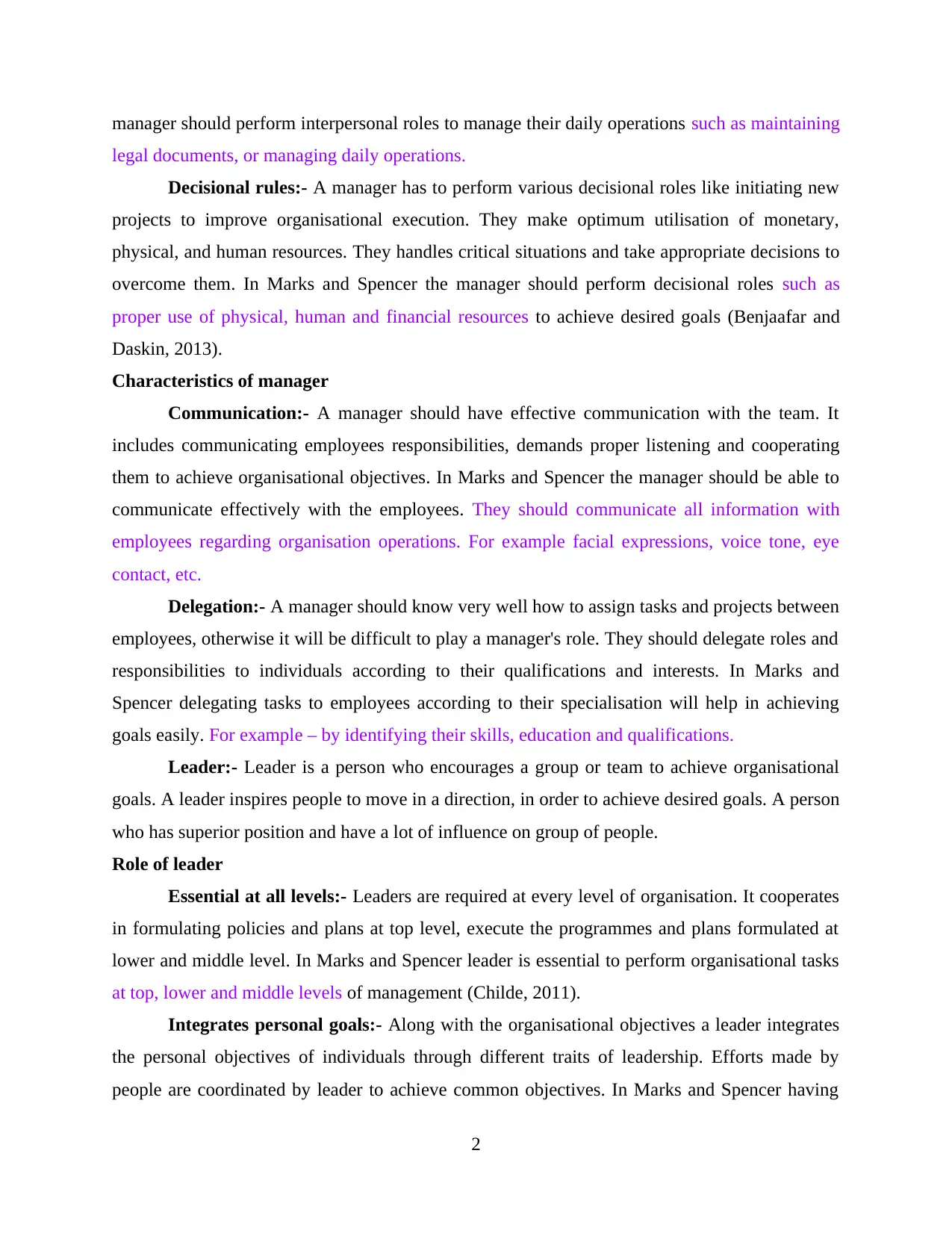
manager should perform interpersonal roles to manage their daily operations such as maintaining
legal documents, or managing daily operations.
Decisional rules:- A manager has to perform various decisional roles like initiating new
projects to improve organisational execution. They make optimum utilisation of monetary,
physical, and human resources. They handles critical situations and take appropriate decisions to
overcome them. In Marks and Spencer the manager should perform decisional roles such as
proper use of physical, human and financial resources to achieve desired goals (Benjaafar and
Daskin, 2013).
Characteristics of manager
Communication:- A manager should have effective communication with the team. It
includes communicating employees responsibilities, demands proper listening and cooperating
them to achieve organisational objectives. In Marks and Spencer the manager should be able to
communicate effectively with the employees. They should communicate all information with
employees regarding organisation operations. For example facial expressions, voice tone, eye
contact, etc.
Delegation:- A manager should know very well how to assign tasks and projects between
employees, otherwise it will be difficult to play a manager's role. They should delegate roles and
responsibilities to individuals according to their qualifications and interests. In Marks and
Spencer delegating tasks to employees according to their specialisation will help in achieving
goals easily. For example – by identifying their skills, education and qualifications.
Leader:- Leader is a person who encourages a group or team to achieve organisational
goals. A leader inspires people to move in a direction, in order to achieve desired goals. A person
who has superior position and have a lot of influence on group of people.
Role of leader
Essential at all levels:- Leaders are required at every level of organisation. It cooperates
in formulating policies and plans at top level, execute the programmes and plans formulated at
lower and middle level. In Marks and Spencer leader is essential to perform organisational tasks
at top, lower and middle levels of management (Childe, 2011).
Integrates personal goals:- Along with the organisational objectives a leader integrates
the personal objectives of individuals through different traits of leadership. Efforts made by
people are coordinated by leader to achieve common objectives. In Marks and Spencer having
2
legal documents, or managing daily operations.
Decisional rules:- A manager has to perform various decisional roles like initiating new
projects to improve organisational execution. They make optimum utilisation of monetary,
physical, and human resources. They handles critical situations and take appropriate decisions to
overcome them. In Marks and Spencer the manager should perform decisional roles such as
proper use of physical, human and financial resources to achieve desired goals (Benjaafar and
Daskin, 2013).
Characteristics of manager
Communication:- A manager should have effective communication with the team. It
includes communicating employees responsibilities, demands proper listening and cooperating
them to achieve organisational objectives. In Marks and Spencer the manager should be able to
communicate effectively with the employees. They should communicate all information with
employees regarding organisation operations. For example facial expressions, voice tone, eye
contact, etc.
Delegation:- A manager should know very well how to assign tasks and projects between
employees, otherwise it will be difficult to play a manager's role. They should delegate roles and
responsibilities to individuals according to their qualifications and interests. In Marks and
Spencer delegating tasks to employees according to their specialisation will help in achieving
goals easily. For example – by identifying their skills, education and qualifications.
Leader:- Leader is a person who encourages a group or team to achieve organisational
goals. A leader inspires people to move in a direction, in order to achieve desired goals. A person
who has superior position and have a lot of influence on group of people.
Role of leader
Essential at all levels:- Leaders are required at every level of organisation. It cooperates
in formulating policies and plans at top level, execute the programmes and plans formulated at
lower and middle level. In Marks and Spencer leader is essential to perform organisational tasks
at top, lower and middle levels of management (Childe, 2011).
Integrates personal goals:- Along with the organisational objectives a leader integrates
the personal objectives of individuals through different traits of leadership. Efforts made by
people are coordinated by leader to achieve common objectives. In Marks and Spencer having
2
Paraphrase This Document
Need a fresh take? Get an instant paraphrase of this document with our AI Paraphraser
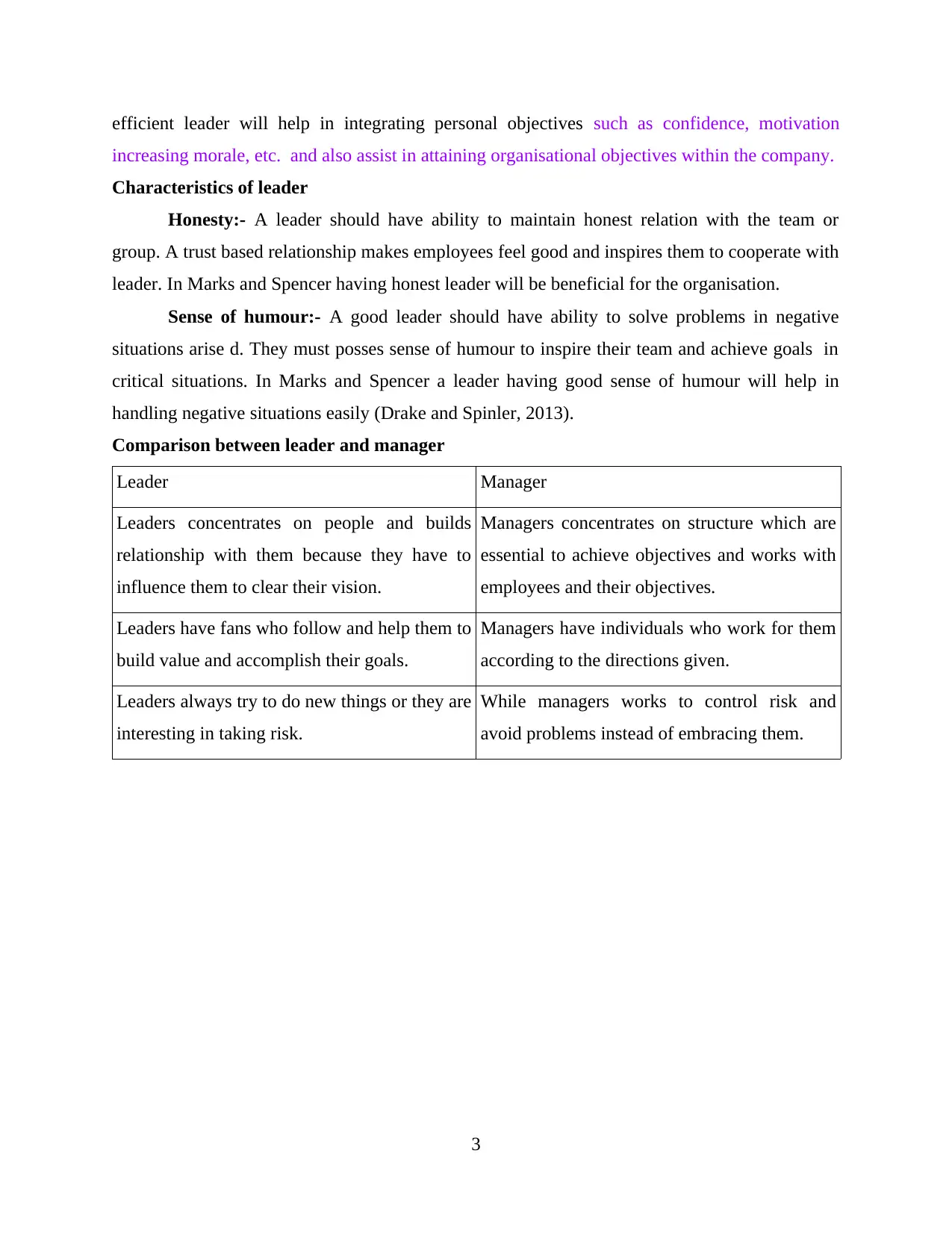
efficient leader will help in integrating personal objectives such as confidence, motivation
increasing morale, etc. and also assist in attaining organisational objectives within the company.
Characteristics of leader
Honesty:- A leader should have ability to maintain honest relation with the team or
group. A trust based relationship makes employees feel good and inspires them to cooperate with
leader. In Marks and Spencer having honest leader will be beneficial for the organisation.
Sense of humour:- A good leader should have ability to solve problems in negative
situations arise d. They must posses sense of humour to inspire their team and achieve goals in
critical situations. In Marks and Spencer a leader having good sense of humour will help in
handling negative situations easily (Drake and Spinler, 2013).
Comparison between leader and manager
Leader Manager
Leaders concentrates on people and builds
relationship with them because they have to
influence them to clear their vision.
Managers concentrates on structure which are
essential to achieve objectives and works with
employees and their objectives.
Leaders have fans who follow and help them to
build value and accomplish their goals.
Managers have individuals who work for them
according to the directions given.
Leaders always try to do new things or they are
interesting in taking risk.
While managers works to control risk and
avoid problems instead of embracing them.
3
increasing morale, etc. and also assist in attaining organisational objectives within the company.
Characteristics of leader
Honesty:- A leader should have ability to maintain honest relation with the team or
group. A trust based relationship makes employees feel good and inspires them to cooperate with
leader. In Marks and Spencer having honest leader will be beneficial for the organisation.
Sense of humour:- A good leader should have ability to solve problems in negative
situations arise d. They must posses sense of humour to inspire their team and achieve goals in
critical situations. In Marks and Spencer a leader having good sense of humour will help in
handling negative situations easily (Drake and Spinler, 2013).
Comparison between leader and manager
Leader Manager
Leaders concentrates on people and builds
relationship with them because they have to
influence them to clear their vision.
Managers concentrates on structure which are
essential to achieve objectives and works with
employees and their objectives.
Leaders have fans who follow and help them to
build value and accomplish their goals.
Managers have individuals who work for them
according to the directions given.
Leaders always try to do new things or they are
interesting in taking risk.
While managers works to control risk and
avoid problems instead of embracing them.
3
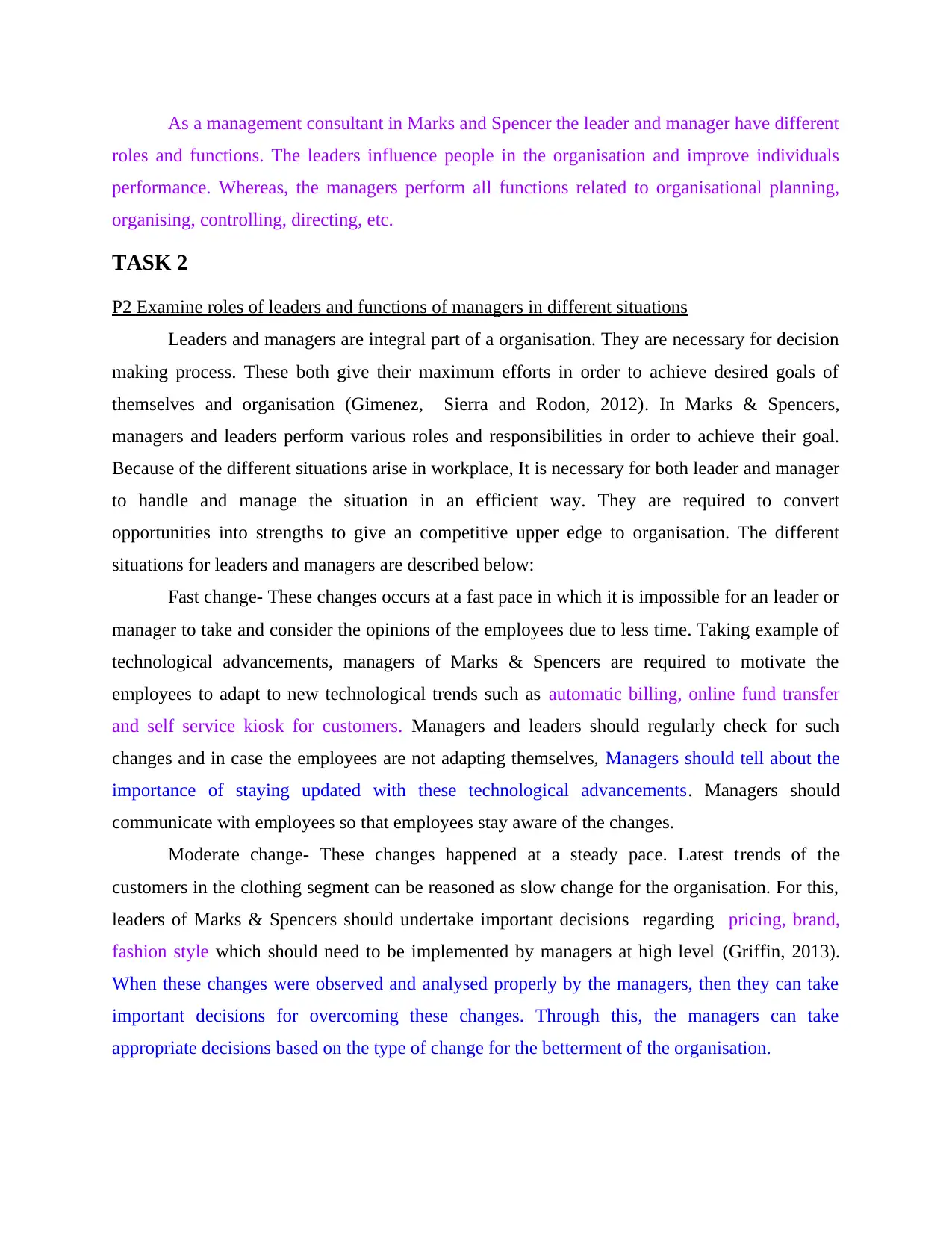
As a management consultant in Marks and Spencer the leader and manager have different
roles and functions. The leaders influence people in the organisation and improve individuals
performance. Whereas, the managers perform all functions related to organisational planning,
organising, controlling, directing, etc.
TASK 2
P2 Examine roles of leaders and functions of managers in different situations
Leaders and managers are integral part of a organisation. They are necessary for decision
making process. These both give their maximum efforts in order to achieve desired goals of
themselves and organisation (Gimenez, Sierra and Rodon, 2012). In Marks & Spencers,
managers and leaders perform various roles and responsibilities in order to achieve their goal.
Because of the different situations arise in workplace, It is necessary for both leader and manager
to handle and manage the situation in an efficient way. They are required to convert
opportunities into strengths to give an competitive upper edge to organisation. The different
situations for leaders and managers are described below:
Fast change- These changes occurs at a fast pace in which it is impossible for an leader or
manager to take and consider the opinions of the employees due to less time. Taking example of
technological advancements, managers of Marks & Spencers are required to motivate the
employees to adapt to new technological trends such as automatic billing, online fund transfer
and self service kiosk for customers. Managers and leaders should regularly check for such
changes and in case the employees are not adapting themselves, Managers should tell about the
importance of staying updated with these technological advancements. Managers should
communicate with employees so that employees stay aware of the changes.
Moderate change- These changes happened at a steady pace. Latest trends of the
customers in the clothing segment can be reasoned as slow change for the organisation. For this,
leaders of Marks & Spencers should undertake important decisions regarding pricing, brand,
fashion style which should need to be implemented by managers at high level (Griffin, 2013).
When these changes were observed and analysed properly by the managers, then they can take
important decisions for overcoming these changes. Through this, the managers can take
appropriate decisions based on the type of change for the betterment of the organisation.
roles and functions. The leaders influence people in the organisation and improve individuals
performance. Whereas, the managers perform all functions related to organisational planning,
organising, controlling, directing, etc.
TASK 2
P2 Examine roles of leaders and functions of managers in different situations
Leaders and managers are integral part of a organisation. They are necessary for decision
making process. These both give their maximum efforts in order to achieve desired goals of
themselves and organisation (Gimenez, Sierra and Rodon, 2012). In Marks & Spencers,
managers and leaders perform various roles and responsibilities in order to achieve their goal.
Because of the different situations arise in workplace, It is necessary for both leader and manager
to handle and manage the situation in an efficient way. They are required to convert
opportunities into strengths to give an competitive upper edge to organisation. The different
situations for leaders and managers are described below:
Fast change- These changes occurs at a fast pace in which it is impossible for an leader or
manager to take and consider the opinions of the employees due to less time. Taking example of
technological advancements, managers of Marks & Spencers are required to motivate the
employees to adapt to new technological trends such as automatic billing, online fund transfer
and self service kiosk for customers. Managers and leaders should regularly check for such
changes and in case the employees are not adapting themselves, Managers should tell about the
importance of staying updated with these technological advancements. Managers should
communicate with employees so that employees stay aware of the changes.
Moderate change- These changes happened at a steady pace. Latest trends of the
customers in the clothing segment can be reasoned as slow change for the organisation. For this,
leaders of Marks & Spencers should undertake important decisions regarding pricing, brand,
fashion style which should need to be implemented by managers at high level (Griffin, 2013).
When these changes were observed and analysed properly by the managers, then they can take
important decisions for overcoming these changes. Through this, the managers can take
appropriate decisions based on the type of change for the betterment of the organisation.
⊘ This is a preview!⊘
Do you want full access?
Subscribe today to unlock all pages.

Trusted by 1+ million students worldwide
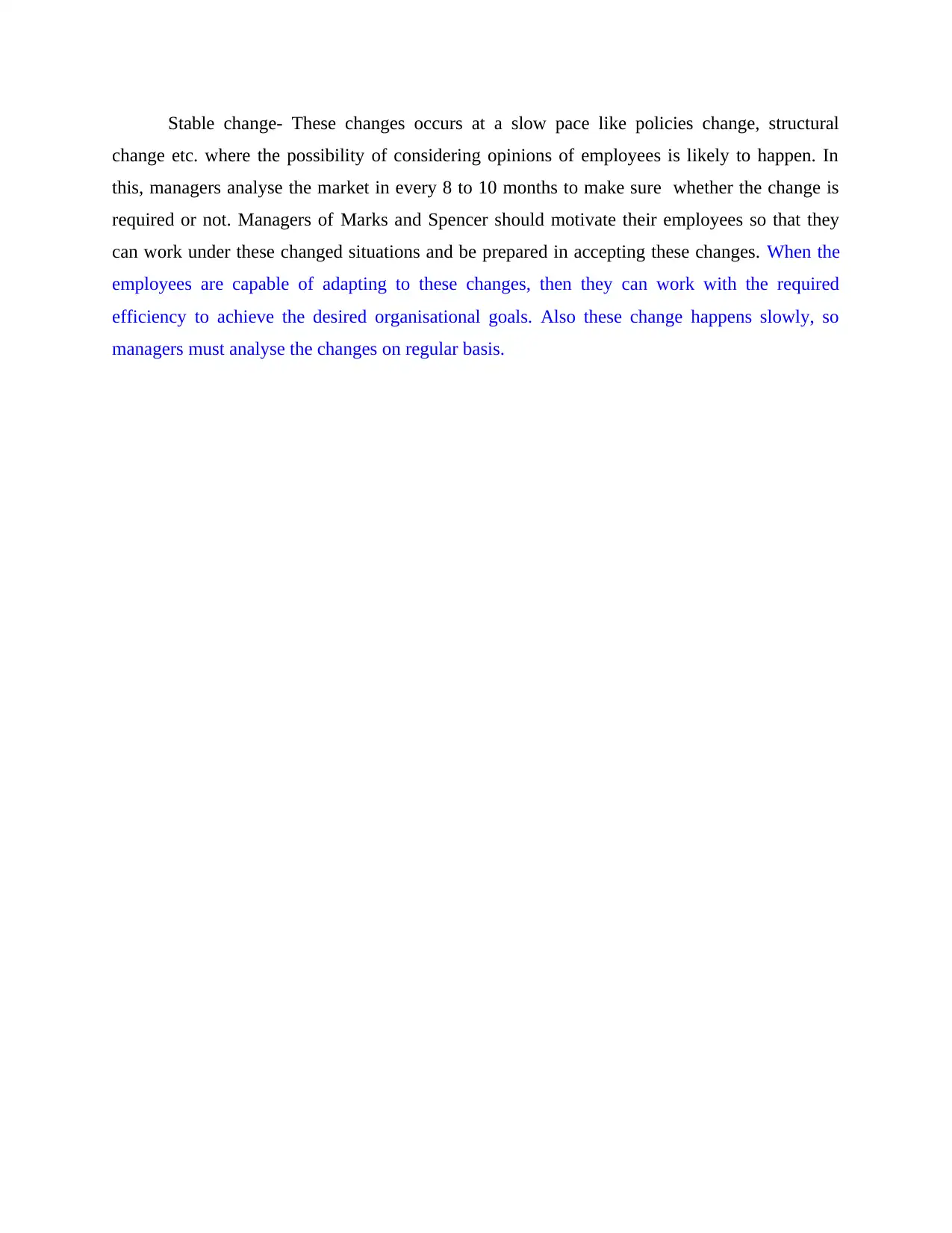
Stable change- These changes occurs at a slow pace like policies change, structural
change etc. where the possibility of considering opinions of employees is likely to happen. In
this, managers analyse the market in every 8 to 10 months to make sure whether the change is
required or not. Managers of Marks and Spencer should motivate their employees so that they
can work under these changed situations and be prepared in accepting these changes. When the
employees are capable of adapting to these changes, then they can work with the required
efficiency to achieve the desired organisational goals. Also these change happens slowly, so
managers must analyse the changes on regular basis.
change etc. where the possibility of considering opinions of employees is likely to happen. In
this, managers analyse the market in every 8 to 10 months to make sure whether the change is
required or not. Managers of Marks and Spencer should motivate their employees so that they
can work under these changed situations and be prepared in accepting these changes. When the
employees are capable of adapting to these changes, then they can work with the required
efficiency to achieve the desired organisational goals. Also these change happens slowly, so
managers must analyse the changes on regular basis.
Paraphrase This Document
Need a fresh take? Get an instant paraphrase of this document with our AI Paraphraser
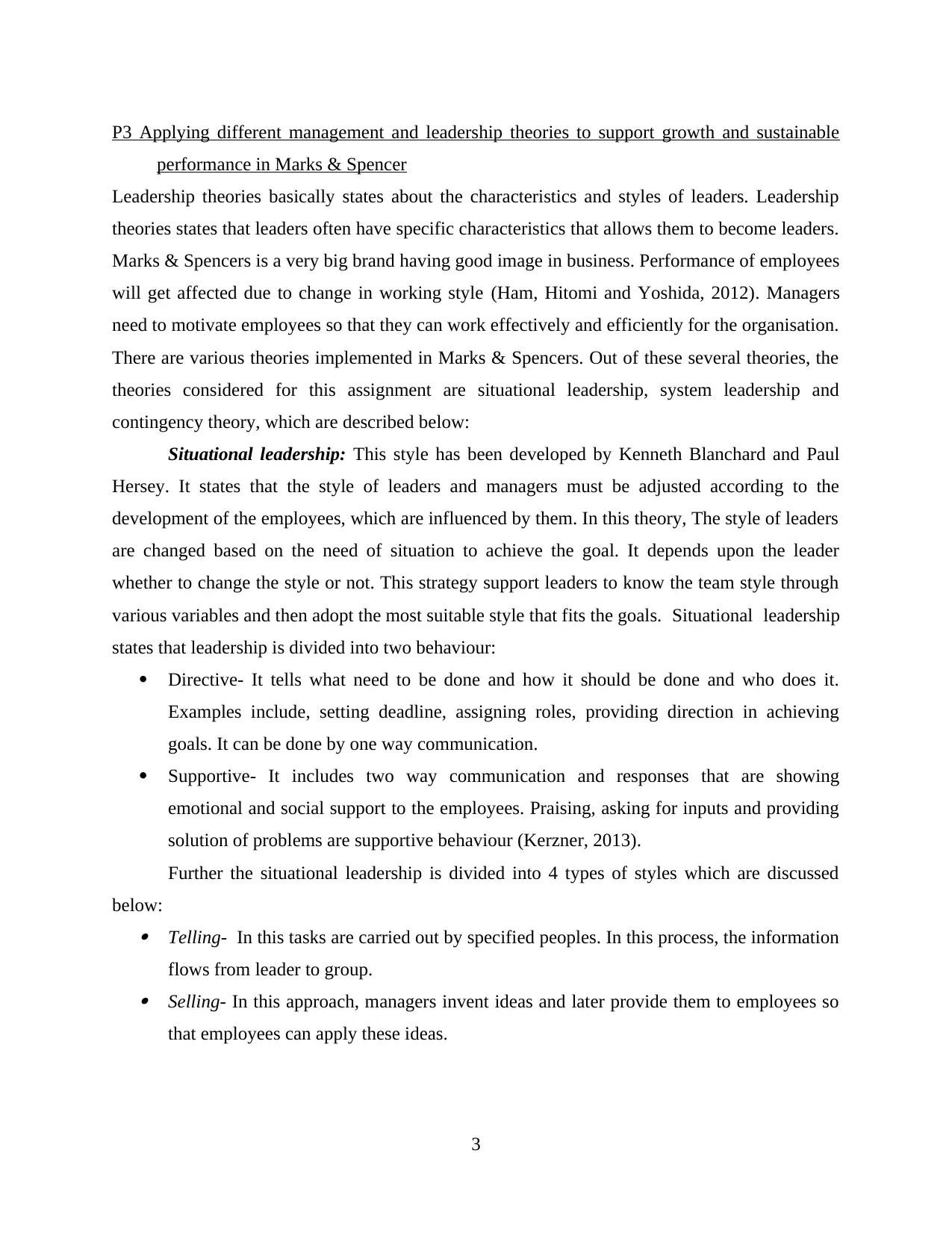
P3 Applying different management and leadership theories to support growth and sustainable
performance in Marks & Spencer
Leadership theories basically states about the characteristics and styles of leaders. Leadership
theories states that leaders often have specific characteristics that allows them to become leaders.
Marks & Spencers is a very big brand having good image in business. Performance of employees
will get affected due to change in working style (Ham, Hitomi and Yoshida, 2012). Managers
need to motivate employees so that they can work effectively and efficiently for the organisation.
There are various theories implemented in Marks & Spencers. Out of these several theories, the
theories considered for this assignment are situational leadership, system leadership and
contingency theory, which are described below:
Situational leadership: This style has been developed by Kenneth Blanchard and Paul
Hersey. It states that the style of leaders and managers must be adjusted according to the
development of the employees, which are influenced by them. In this theory, The style of leaders
are changed based on the need of situation to achieve the goal. It depends upon the leader
whether to change the style or not. This strategy support leaders to know the team style through
various variables and then adopt the most suitable style that fits the goals. Situational leadership
states that leadership is divided into two behaviour:
Directive- It tells what need to be done and how it should be done and who does it.
Examples include, setting deadline, assigning roles, providing direction in achieving
goals. It can be done by one way communication.
Supportive- It includes two way communication and responses that are showing
emotional and social support to the employees. Praising, asking for inputs and providing
solution of problems are supportive behaviour (Kerzner, 2013).
Further the situational leadership is divided into 4 types of styles which are discussed
below: Telling- In this tasks are carried out by specified peoples. In this process, the information
flows from leader to group. Selling- In this approach, managers invent ideas and later provide them to employees so
that employees can apply these ideas.
3
performance in Marks & Spencer
Leadership theories basically states about the characteristics and styles of leaders. Leadership
theories states that leaders often have specific characteristics that allows them to become leaders.
Marks & Spencers is a very big brand having good image in business. Performance of employees
will get affected due to change in working style (Ham, Hitomi and Yoshida, 2012). Managers
need to motivate employees so that they can work effectively and efficiently for the organisation.
There are various theories implemented in Marks & Spencers. Out of these several theories, the
theories considered for this assignment are situational leadership, system leadership and
contingency theory, which are described below:
Situational leadership: This style has been developed by Kenneth Blanchard and Paul
Hersey. It states that the style of leaders and managers must be adjusted according to the
development of the employees, which are influenced by them. In this theory, The style of leaders
are changed based on the need of situation to achieve the goal. It depends upon the leader
whether to change the style or not. This strategy support leaders to know the team style through
various variables and then adopt the most suitable style that fits the goals. Situational leadership
states that leadership is divided into two behaviour:
Directive- It tells what need to be done and how it should be done and who does it.
Examples include, setting deadline, assigning roles, providing direction in achieving
goals. It can be done by one way communication.
Supportive- It includes two way communication and responses that are showing
emotional and social support to the employees. Praising, asking for inputs and providing
solution of problems are supportive behaviour (Kerzner, 2013).
Further the situational leadership is divided into 4 types of styles which are discussed
below: Telling- In this tasks are carried out by specified peoples. In this process, the information
flows from leader to group. Selling- In this approach, managers invent ideas and later provide them to employees so
that employees can apply these ideas.
3
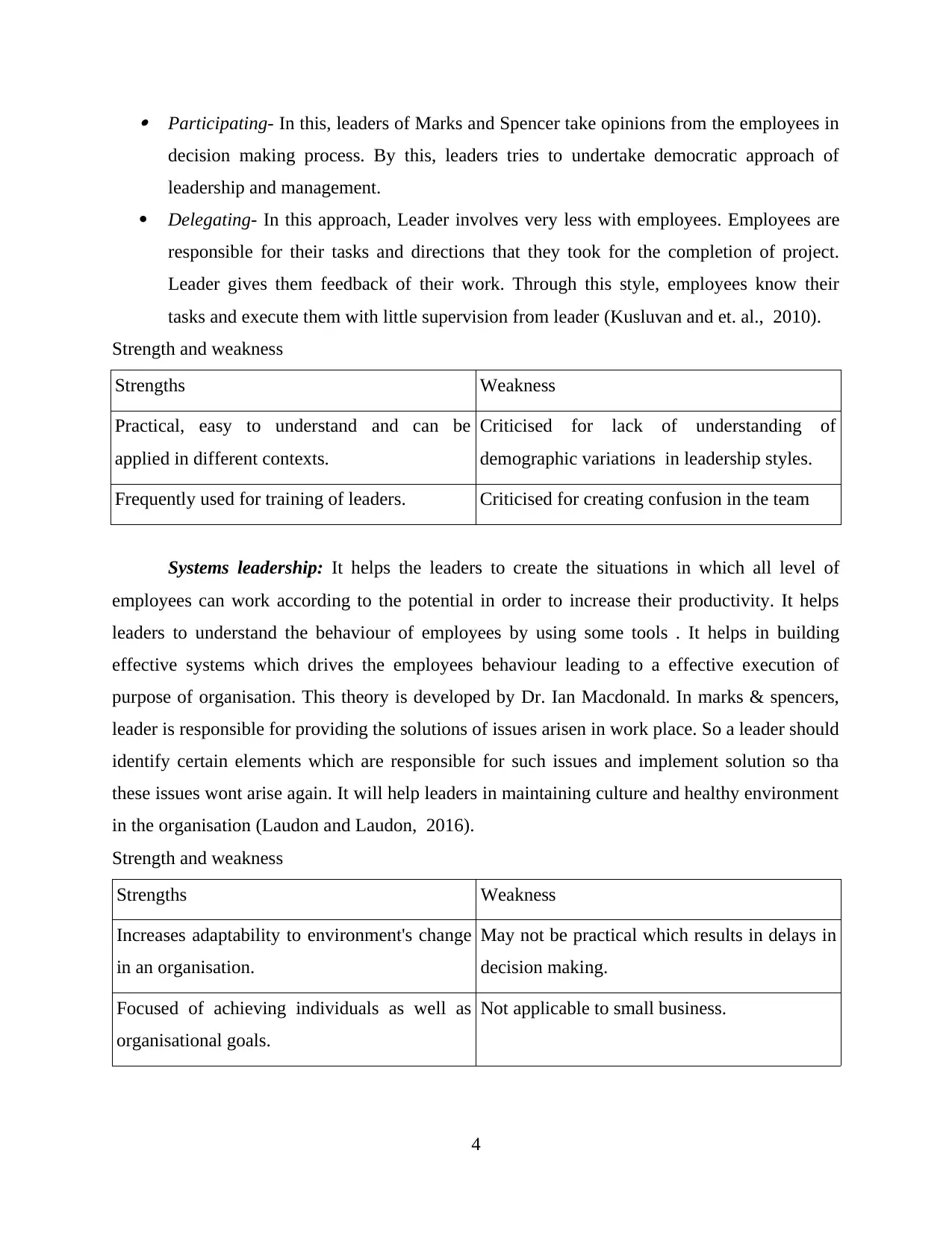
Participating- In this, leaders of Marks and Spencer take opinions from the employees in
decision making process. By this, leaders tries to undertake democratic approach of
leadership and management.
Delegating- In this approach, Leader involves very less with employees. Employees are
responsible for their tasks and directions that they took for the completion of project.
Leader gives them feedback of their work. Through this style, employees know their
tasks and execute them with little supervision from leader (Kusluvan and et. al., 2010).
Strength and weakness
Strengths Weakness
Practical, easy to understand and can be
applied in different contexts.
Criticised for lack of understanding of
demographic variations in leadership styles.
Frequently used for training of leaders. Criticised for creating confusion in the team
Systems leadership: It helps the leaders to create the situations in which all level of
employees can work according to the potential in order to increase their productivity. It helps
leaders to understand the behaviour of employees by using some tools . It helps in building
effective systems which drives the employees behaviour leading to a effective execution of
purpose of organisation. This theory is developed by Dr. Ian Macdonald. In marks & spencers,
leader is responsible for providing the solutions of issues arisen in work place. So a leader should
identify certain elements which are responsible for such issues and implement solution so tha
these issues wont arise again. It will help leaders in maintaining culture and healthy environment
in the organisation (Laudon and Laudon, 2016).
Strength and weakness
Strengths Weakness
Increases adaptability to environment's change
in an organisation.
May not be practical which results in delays in
decision making.
Focused of achieving individuals as well as
organisational goals.
Not applicable to small business.
4
decision making process. By this, leaders tries to undertake democratic approach of
leadership and management.
Delegating- In this approach, Leader involves very less with employees. Employees are
responsible for their tasks and directions that they took for the completion of project.
Leader gives them feedback of their work. Through this style, employees know their
tasks and execute them with little supervision from leader (Kusluvan and et. al., 2010).
Strength and weakness
Strengths Weakness
Practical, easy to understand and can be
applied in different contexts.
Criticised for lack of understanding of
demographic variations in leadership styles.
Frequently used for training of leaders. Criticised for creating confusion in the team
Systems leadership: It helps the leaders to create the situations in which all level of
employees can work according to the potential in order to increase their productivity. It helps
leaders to understand the behaviour of employees by using some tools . It helps in building
effective systems which drives the employees behaviour leading to a effective execution of
purpose of organisation. This theory is developed by Dr. Ian Macdonald. In marks & spencers,
leader is responsible for providing the solutions of issues arisen in work place. So a leader should
identify certain elements which are responsible for such issues and implement solution so tha
these issues wont arise again. It will help leaders in maintaining culture and healthy environment
in the organisation (Laudon and Laudon, 2016).
Strength and weakness
Strengths Weakness
Increases adaptability to environment's change
in an organisation.
May not be practical which results in delays in
decision making.
Focused of achieving individuals as well as
organisational goals.
Not applicable to small business.
4
⊘ This is a preview!⊘
Do you want full access?
Subscribe today to unlock all pages.

Trusted by 1+ million students worldwide
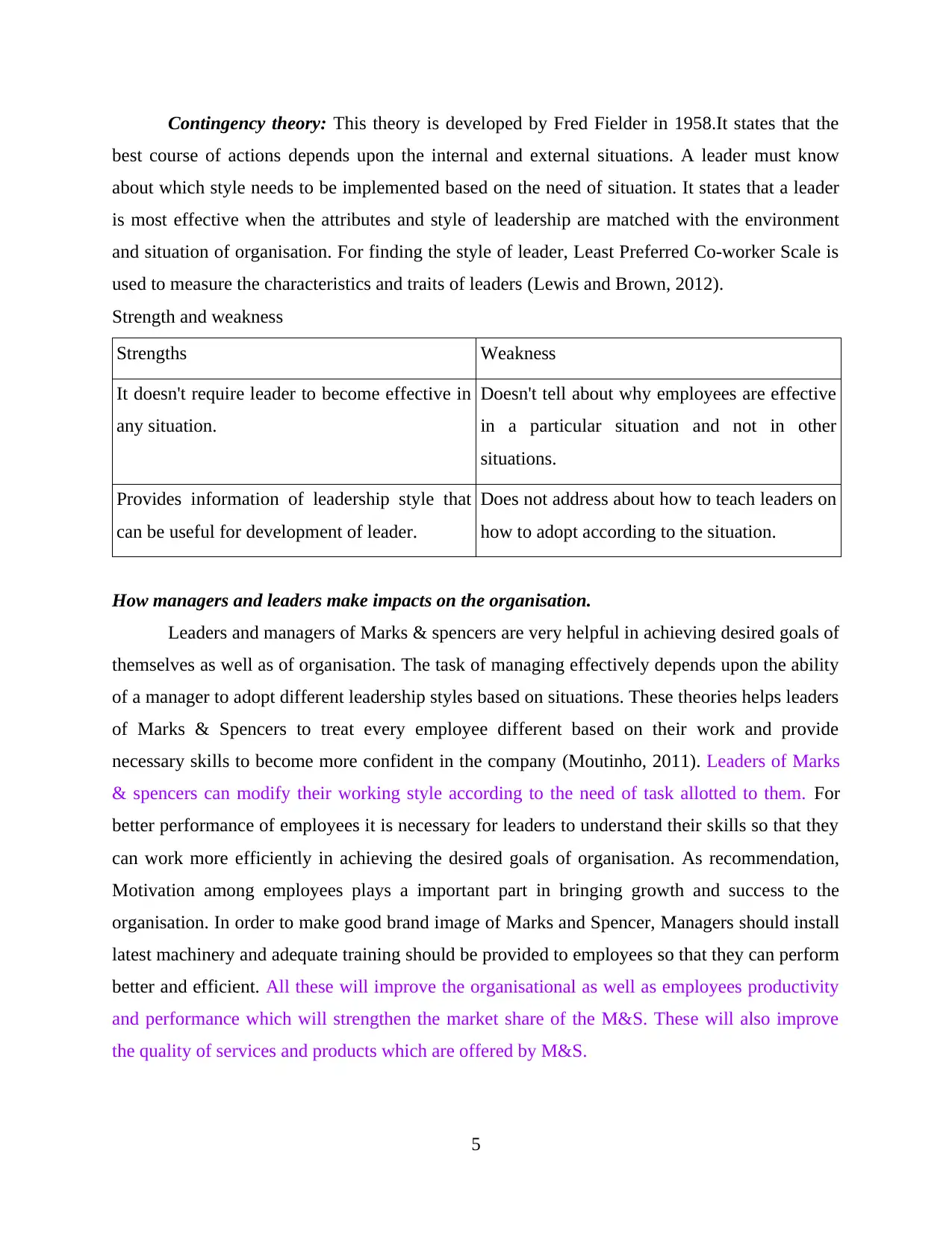
Contingency theory: This theory is developed by Fred Fielder in 1958.It states that the
best course of actions depends upon the internal and external situations. A leader must know
about which style needs to be implemented based on the need of situation. It states that a leader
is most effective when the attributes and style of leadership are matched with the environment
and situation of organisation. For finding the style of leader, Least Preferred Co-worker Scale is
used to measure the characteristics and traits of leaders (Lewis and Brown, 2012).
Strength and weakness
Strengths Weakness
It doesn't require leader to become effective in
any situation.
Doesn't tell about why employees are effective
in a particular situation and not in other
situations.
Provides information of leadership style that
can be useful for development of leader.
Does not address about how to teach leaders on
how to adopt according to the situation.
How managers and leaders make impacts on the organisation.
Leaders and managers of Marks & spencers are very helpful in achieving desired goals of
themselves as well as of organisation. The task of managing effectively depends upon the ability
of a manager to adopt different leadership styles based on situations. These theories helps leaders
of Marks & Spencers to treat every employee different based on their work and provide
necessary skills to become more confident in the company (Moutinho, 2011). Leaders of Marks
& spencers can modify their working style according to the need of task allotted to them. For
better performance of employees it is necessary for leaders to understand their skills so that they
can work more efficiently in achieving the desired goals of organisation. As recommendation,
Motivation among employees plays a important part in bringing growth and success to the
organisation. In order to make good brand image of Marks and Spencer, Managers should install
latest machinery and adequate training should be provided to employees so that they can perform
better and efficient. All these will improve the organisational as well as employees productivity
and performance which will strengthen the market share of the M&S. These will also improve
the quality of services and products which are offered by M&S.
5
best course of actions depends upon the internal and external situations. A leader must know
about which style needs to be implemented based on the need of situation. It states that a leader
is most effective when the attributes and style of leadership are matched with the environment
and situation of organisation. For finding the style of leader, Least Preferred Co-worker Scale is
used to measure the characteristics and traits of leaders (Lewis and Brown, 2012).
Strength and weakness
Strengths Weakness
It doesn't require leader to become effective in
any situation.
Doesn't tell about why employees are effective
in a particular situation and not in other
situations.
Provides information of leadership style that
can be useful for development of leader.
Does not address about how to teach leaders on
how to adopt according to the situation.
How managers and leaders make impacts on the organisation.
Leaders and managers of Marks & spencers are very helpful in achieving desired goals of
themselves as well as of organisation. The task of managing effectively depends upon the ability
of a manager to adopt different leadership styles based on situations. These theories helps leaders
of Marks & Spencers to treat every employee different based on their work and provide
necessary skills to become more confident in the company (Moutinho, 2011). Leaders of Marks
& spencers can modify their working style according to the need of task allotted to them. For
better performance of employees it is necessary for leaders to understand their skills so that they
can work more efficiently in achieving the desired goals of organisation. As recommendation,
Motivation among employees plays a important part in bringing growth and success to the
organisation. In order to make good brand image of Marks and Spencer, Managers should install
latest machinery and adequate training should be provided to employees so that they can perform
better and efficient. All these will improve the organisational as well as employees productivity
and performance which will strengthen the market share of the M&S. These will also improve
the quality of services and products which are offered by M&S.
5
Paraphrase This Document
Need a fresh take? Get an instant paraphrase of this document with our AI Paraphraser
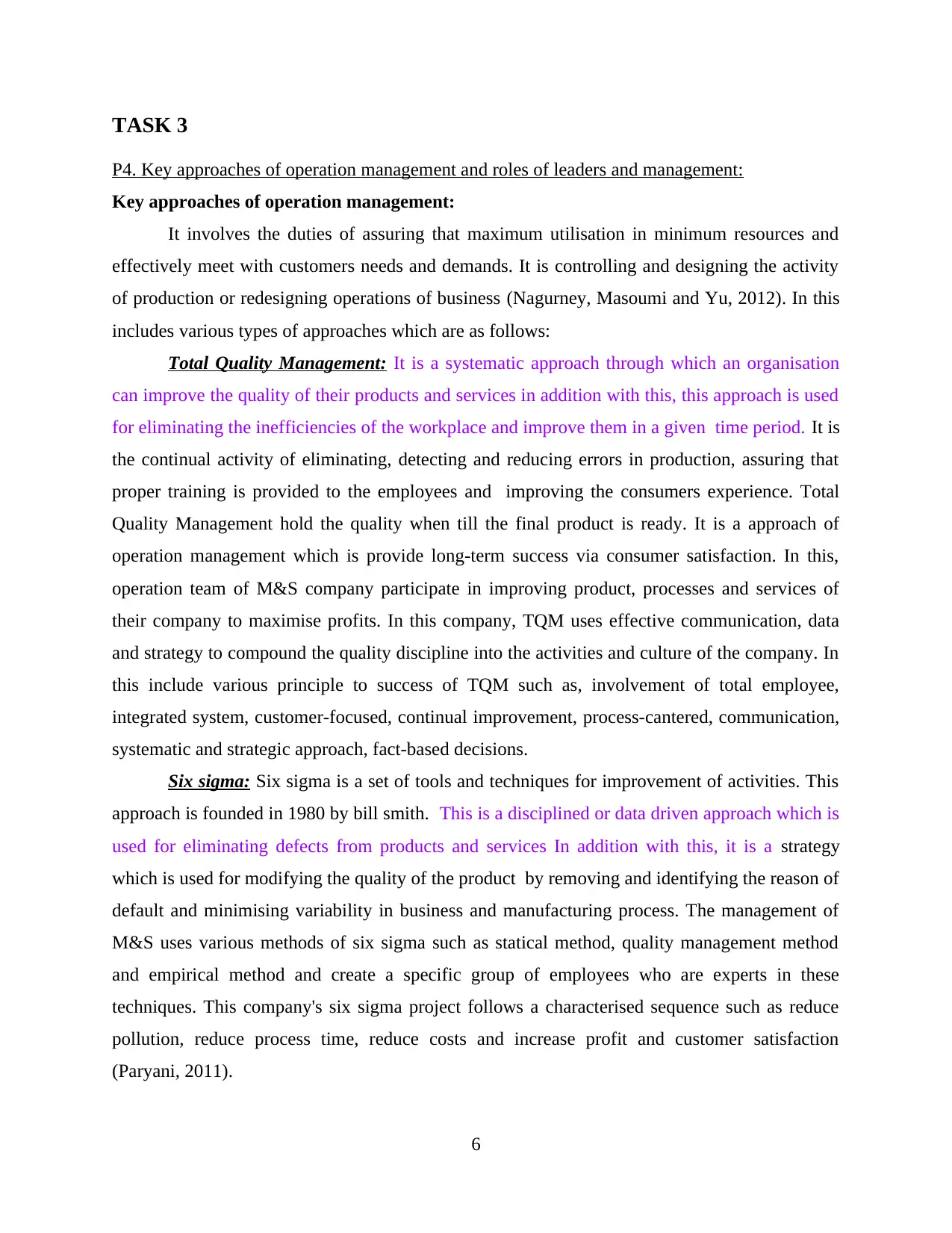
TASK 3
P4. Key approaches of operation management and roles of leaders and management:
Key approaches of operation management:
It involves the duties of assuring that maximum utilisation in minimum resources and
effectively meet with customers needs and demands. It is controlling and designing the activity
of production or redesigning operations of business (Nagurney, Masoumi and Yu, 2012). In this
includes various types of approaches which are as follows:
Total Quality Management: It is a systematic approach through which an organisation
can improve the quality of their products and services in addition with this, this approach is used
for eliminating the inefficiencies of the workplace and improve them in a given time period. It is
the continual activity of eliminating, detecting and reducing errors in production, assuring that
proper training is provided to the employees and improving the consumers experience. Total
Quality Management hold the quality when till the final product is ready. It is a approach of
operation management which is provide long-term success via consumer satisfaction. In this,
operation team of M&S company participate in improving product, processes and services of
their company to maximise profits. In this company, TQM uses effective communication, data
and strategy to compound the quality discipline into the activities and culture of the company. In
this include various principle to success of TQM such as, involvement of total employee,
integrated system, customer-focused, continual improvement, process-cantered, communication,
systematic and strategic approach, fact-based decisions.
Six sigma: Six sigma is a set of tools and techniques for improvement of activities. This
approach is founded in 1980 by bill smith. This is a disciplined or data driven approach which is
used for eliminating defects from products and services In addition with this, it is a strategy
which is used for modifying the quality of the product by removing and identifying the reason of
default and minimising variability in business and manufacturing process. The management of
M&S uses various methods of six sigma such as statical method, quality management method
and empirical method and create a specific group of employees who are experts in these
techniques. This company's six sigma project follows a characterised sequence such as reduce
pollution, reduce process time, reduce costs and increase profit and customer satisfaction
(Paryani, 2011).
6
P4. Key approaches of operation management and roles of leaders and management:
Key approaches of operation management:
It involves the duties of assuring that maximum utilisation in minimum resources and
effectively meet with customers needs and demands. It is controlling and designing the activity
of production or redesigning operations of business (Nagurney, Masoumi and Yu, 2012). In this
includes various types of approaches which are as follows:
Total Quality Management: It is a systematic approach through which an organisation
can improve the quality of their products and services in addition with this, this approach is used
for eliminating the inefficiencies of the workplace and improve them in a given time period. It is
the continual activity of eliminating, detecting and reducing errors in production, assuring that
proper training is provided to the employees and improving the consumers experience. Total
Quality Management hold the quality when till the final product is ready. It is a approach of
operation management which is provide long-term success via consumer satisfaction. In this,
operation team of M&S company participate in improving product, processes and services of
their company to maximise profits. In this company, TQM uses effective communication, data
and strategy to compound the quality discipline into the activities and culture of the company. In
this include various principle to success of TQM such as, involvement of total employee,
integrated system, customer-focused, continual improvement, process-cantered, communication,
systematic and strategic approach, fact-based decisions.
Six sigma: Six sigma is a set of tools and techniques for improvement of activities. This
approach is founded in 1980 by bill smith. This is a disciplined or data driven approach which is
used for eliminating defects from products and services In addition with this, it is a strategy
which is used for modifying the quality of the product by removing and identifying the reason of
default and minimising variability in business and manufacturing process. The management of
M&S uses various methods of six sigma such as statical method, quality management method
and empirical method and create a specific group of employees who are experts in these
techniques. This company's six sigma project follows a characterised sequence such as reduce
pollution, reduce process time, reduce costs and increase profit and customer satisfaction
(Paryani, 2011).
6
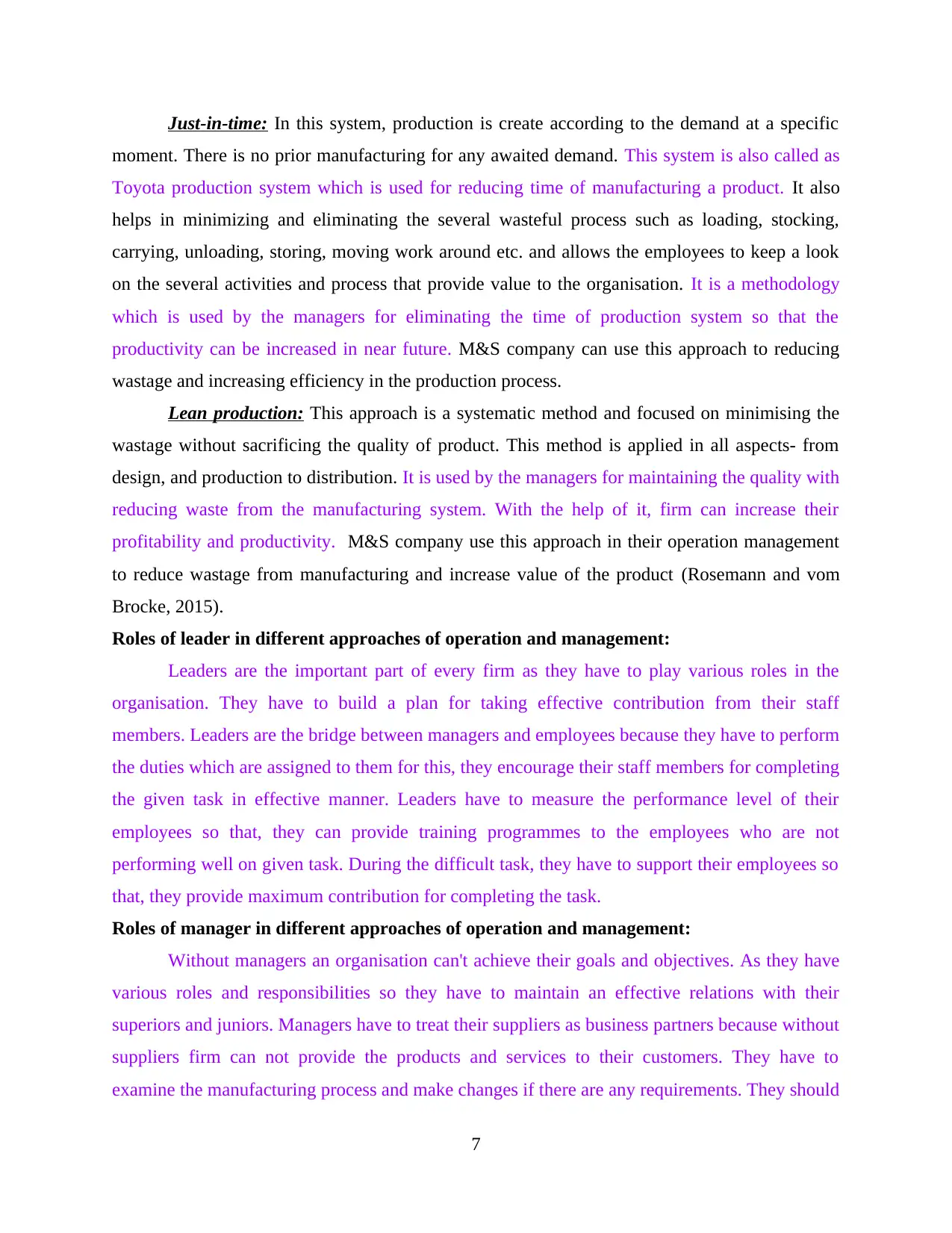
Just-in-time: In this system, production is create according to the demand at a specific
moment. There is no prior manufacturing for any awaited demand. This system is also called as
Toyota production system which is used for reducing time of manufacturing a product. It also
helps in minimizing and eliminating the several wasteful process such as loading, stocking,
carrying, unloading, storing, moving work around etc. and allows the employees to keep a look
on the several activities and process that provide value to the organisation. It is a methodology
which is used by the managers for eliminating the time of production system so that the
productivity can be increased in near future. M&S company can use this approach to reducing
wastage and increasing efficiency in the production process.
Lean production: This approach is a systematic method and focused on minimising the
wastage without sacrificing the quality of product. This method is applied in all aspects- from
design, and production to distribution. It is used by the managers for maintaining the quality with
reducing waste from the manufacturing system. With the help of it, firm can increase their
profitability and productivity. M&S company use this approach in their operation management
to reduce wastage from manufacturing and increase value of the product (Rosemann and vom
Brocke, 2015).
Roles of leader in different approaches of operation and management:
Leaders are the important part of every firm as they have to play various roles in the
organisation. They have to build a plan for taking effective contribution from their staff
members. Leaders are the bridge between managers and employees because they have to perform
the duties which are assigned to them for this, they encourage their staff members for completing
the given task in effective manner. Leaders have to measure the performance level of their
employees so that, they can provide training programmes to the employees who are not
performing well on given task. During the difficult task, they have to support their employees so
that, they provide maximum contribution for completing the task.
Roles of manager in different approaches of operation and management:
Without managers an organisation can't achieve their goals and objectives. As they have
various roles and responsibilities so they have to maintain an effective relations with their
superiors and juniors. Managers have to treat their suppliers as business partners because without
suppliers firm can not provide the products and services to their customers. They have to
examine the manufacturing process and make changes if there are any requirements. They should
7
moment. There is no prior manufacturing for any awaited demand. This system is also called as
Toyota production system which is used for reducing time of manufacturing a product. It also
helps in minimizing and eliminating the several wasteful process such as loading, stocking,
carrying, unloading, storing, moving work around etc. and allows the employees to keep a look
on the several activities and process that provide value to the organisation. It is a methodology
which is used by the managers for eliminating the time of production system so that the
productivity can be increased in near future. M&S company can use this approach to reducing
wastage and increasing efficiency in the production process.
Lean production: This approach is a systematic method and focused on minimising the
wastage without sacrificing the quality of product. This method is applied in all aspects- from
design, and production to distribution. It is used by the managers for maintaining the quality with
reducing waste from the manufacturing system. With the help of it, firm can increase their
profitability and productivity. M&S company use this approach in their operation management
to reduce wastage from manufacturing and increase value of the product (Rosemann and vom
Brocke, 2015).
Roles of leader in different approaches of operation and management:
Leaders are the important part of every firm as they have to play various roles in the
organisation. They have to build a plan for taking effective contribution from their staff
members. Leaders are the bridge between managers and employees because they have to perform
the duties which are assigned to them for this, they encourage their staff members for completing
the given task in effective manner. Leaders have to measure the performance level of their
employees so that, they can provide training programmes to the employees who are not
performing well on given task. During the difficult task, they have to support their employees so
that, they provide maximum contribution for completing the task.
Roles of manager in different approaches of operation and management:
Without managers an organisation can't achieve their goals and objectives. As they have
various roles and responsibilities so they have to maintain an effective relations with their
superiors and juniors. Managers have to treat their suppliers as business partners because without
suppliers firm can not provide the products and services to their customers. They have to
examine the manufacturing process and make changes if there are any requirements. They should
7
⊘ This is a preview!⊘
Do you want full access?
Subscribe today to unlock all pages.

Trusted by 1+ million students worldwide
1 out of 20
Related Documents
Your All-in-One AI-Powered Toolkit for Academic Success.
+13062052269
info@desklib.com
Available 24*7 on WhatsApp / Email
![[object Object]](/_next/static/media/star-bottom.7253800d.svg)
Unlock your academic potential
Copyright © 2020–2025 A2Z Services. All Rights Reserved. Developed and managed by ZUCOL.





